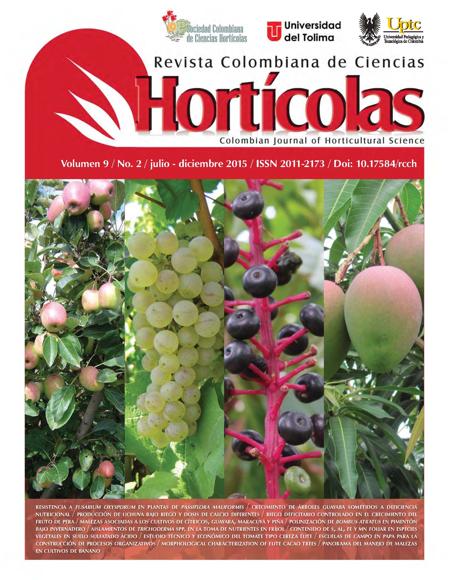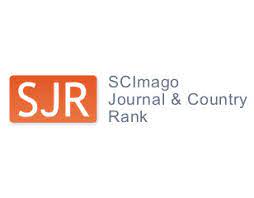Efecto de diversos aislamientos de <i>Trichoderma</i> spp. en la absorción de nutrientes en frijol (<i>Phaseolus vulgaris</i>) en dos tipos de suelo
DOI:
https://doi.org/10.17584/rcch.2015v9i2.4183Keywords:
Microorganismos, solubilización, crecimiento, frijolAbstract
Trichoderma es un género de hongos ampliamente conocido por la supresión de patógenos y la promoción del crecimiento en plantas, aumentando la disponibilidad y la absorción de nutrientes, incrementando concentraciones foliares de nutrientes en diferentes plantas. Con el objetivo de probar y prospectar el uso agrícola de aislamientos nativos colombianos, siete aislamientos previamente seleccionados en pruebas in vitro, fueron probados para medir su efecto sobre los niveles de nutrientes y variables de crecimiento en fríjol bajo condiciones de invernadero. Para ello se sembraron las plantas en un Andisol y en un Ultisol como sustrato, luego estas fueron inoculadas con las diferentes cepas de Trichoderma. En estas plantas de frijol se cuantificó el tiempo para alcanzar las diferentes etapas o estadios del cultivo. En floración se midieron área foliar, número de nudos y materia seca así como la concentración foliar de N, P, K, S, Mg, Ca, Fe, Zn, B, Cu y Mn. En cuanto a solubilización de nutrientes, en plantas establecidas en andisoles, la inoculación con algunos aislamientos de Trichoderma incrementa las concentraciones foliares de Cu, Fe, Ca, Mg y K con diferencias estadísticas significativas. En Ultisoles las concentraciones foliares de P y Cu son mayores en plantas de fríjol inoculadas con Trichoderma, ratificando el efecto positivo del hongo en la concentración foliar de nutrientes. Demostrando que la solubilización de nutrientes por Trichoderma es un fenómeno influenciado por el sustrato o suelo agrícola entre otros factores.
JEL Classification
ArrayDownloads
References
Altomare, C., W. Norvell, T. Björkman y G. Harman. 1999. Solubilization of phosphates and micronutrients by the plant-growth-promoting and biocontrol fungus Trichoderma harzianum Rifai 1295-22. Appl. Environ. Microbiol. 65, 2926-2933.
Bailey, B.A. y R. Lumsden. 1998. Direct effects of Trichoderma and Gliocladium on plant growth and resistance to pathogens. pp. 185-204. En: Harman, G.E. y C.P. Kubicek (eds.). 1998. Trichoderma and Gliocladium, enzymes, biological control and commercial applications. Vol. 2. Taylor & Francis, London.
Baker, R., Y. Elad e I. Chet. 1984. The controlled experiment in the scientific method with special emphasis in biological control. Phytopathology 74, 1019-1021. Doi: 10.1094/Phyto-74-1019
Baquero, J.E. 2012. Los minerales en el suelo. pp. 24-57. En: Manejo de la nutrición mineral en sistemas ganaderos de los Llanos Orientales de Colombia. Corpoica, Bogotá.
Chang, Y., R. Baker, O. Kleifeld e I. Chet. 1986. Increased growth of plants in the presence of the biological control agent Trichoderma harzianum. Plant Dis. 70, 145-148. Doi: 10.1094/PD-70-145
Cuevas, V.C. 2006. Soil inoculation with Trichoderma pseudokoningii Rifai enhances yield of rice. Philip. J. Sci. 135, 31-37.
Druzhinina, I., M. Komoń-Zelazowska, L. Kredics, L. Hatvani, Z. Antal, T. Belayneh y C. Kubicek. 2008. Alternative reproductive strategies of Hypocrea orientalis and genetically close but clonal Trichoderma longibrachiatum, both capable of causing invasive mycoses of humans. Microbiol. 154(11), 3447-3459. Doi: 10.1099/mic.0.2008/021196-0
Guerrero R., R. (1995). Fundamentos técnicos para la fertilización de cultivos. Fertilidad de suelos: diagnóstico y control. pp. 247-281. En: Silva, M.F. (ed.) Fertilidad de suelos, diagnóstico y control. Sociedad Colombiana de la Ciencia del Suelo, Bogotá.
Hoyos-Carvajal, L., P. Chaparro, M. Abramsky, I. Chet y S. Orduz. 2008. Evaluación de aislamientos de Trichoderma spp. contra Rhizoctonia solani y Sclerotium rolfsii bajo condiciones in vitro y de invernadero. Agron. Colomb. 26(3), 451-458.
Hoyos-Carvajal, L., G. Duque y S. Orduz. 2011. Antagonismo in vitro de Trichoderma spp. sobre aislamientos de Sclerotinia spp. y Rhizoctonia spp. Rev. Colomb. Cienc. Hortic. 2(1), 76-86. Doi: 10.17584/rcch.2008v2i1.1175
Hoyos-Carvajal, L., S. Orduz y J. Bissett. 2009a. Genetic and metabolic biodiversity of Trichoderma from Colombia and adjacent neotropic regions. Fungal Genet. Biol. 46(9), 615-631. Doi: 10.1016/j.fgb.2009.04.006
Hoyos-Carvajal, L., S. Orduz y J. Bissett. 2009b. Growth stimulation in bean (Phaseolus vulgaris L.) by Trichoderma. Biol. Control. 51(3), 409-416. Doi: 10.1016/j.biocontrol.2009.07.018
Jones, J., J. Wolf y H. Mills. 1991. Plant analysis handbook. Micro-macro publishing, Athens, GA.
Kleifeld, O. e I. Chet. 1992. Trichoderma harzianum - interaction with plants and effect on growth response. Plant Soil 144, 267-272. Doi: 10.1007/BF00012884
Li, R. X., F. Cai, G. Pang, Q. Shen, R. Li y W. Chen. 2015. Solubilization of phosphate and micronutrients by Trichoderma harzianum and its relationship with the promotion of tomato plant growth. PloS ONE 10(6). Doi: 10.1371/journal.pone.0130081
Lu, Z. X., R. Tombolini, S. Woo, S. Zeilinger, M. Lorito y J.K. Jansson. 2004. In vivo study of Trichoderma–pathogen–plant interactions, using constitutive and inducible green fluorescent protein reporter systems. Appl. Environ. Microbiol. 70, 3073-3081. Doi: 10.1128/AEM.70.5.3073-3081.2004
Marschner, P. (ed.). 2012. Marschner's mineral nutrition of higher plants. 3rd ed. Elsevier, Amsterdam, The Netherlands.
McDaniel, P.A., D.J. Lowe, O. Arnalds y C.-L. Ping. 2012. Andisols. pp. 33.29-22.48. En: Huangg, P.M., Y. Li y M.E. Summer (eds.). Handbook of soil sciences. 2nd ed. Vol 1: Properties and processes. CRC Press, Boca Raton, FL.
Nehra, V. y M. Choudhary. 2015. A review on plant growth promoting rhizobacteria acting as bioinoculants and their biological approach towards the production of sustainable agriculture. J. Appl. Nat. Sci. 7(1), 540-556.
Öğüt, M. y F. Er. 2006. Micronutrient composition of field‐grown dry bean and wheat inoculated with Azospirillum and Trichoderma. J. Plant Nutr. Soil Sci. 169(5), 699-703. Doi: 10.1002/jpln.200520597
Ortega-García, J.G., R. Montes-Belmont, M. Rodríguez-Monroy, J. Ramírez-Trujillo, R. Suárez-Rodríguez y G. Sepúlveda-Jiménez. 2015. Effect of Trichoderma asperellum applications and mineral fertilization on growth promotion and the content of phenolic compounds and flavonoids in onions. Sci. Hortic. 195, 8-16. Doi: 10.1016/j.scienta.2015.08.027
Osorio, N.W. y M. Habte. 2014. Soil phosphate desorption induced by a phosphate-solubilizing fungus. Comm. Soil Sci. Plant Anal. 45(4), 451-460. Doi: 10.1080/00103624.2013.870190
Porras, M., C. Barrau y F. Romero. 2007. Effects of soil solarization and Trichoderma on strawberry production. Crop Prot. 26(5), 782-787. Doi: 10.1016/j.cropro.2006.07.005
Rawat, R. y L. Tewari. 2011. Effect of abiotic stress on phosphate solubilization by biocontrol fungus Trichoderma sp. Curr. Microbiol. 62(5), 1521-1526. Doi: 10.1007/s00284-011-9888-2
Rojas, E. y L. Lora. 1989. El análisis de suelos, plantas y aguas para riego. pp. 175-209. En: Rojas, E., G. Gonzáles, A. García, L. Castillo, G. Ortiz, E. Amézquita, R. Lora y J. Navas (eds.). El análisis de suelos, plantas y aguas para riego. Manual ICA de Asistencia Técnica Nº 47. Instituto Colombiano Agropecuario, Bogotá.
Rosales-Serna, R., J. Kohashi-Shibata, J.A. Acosta-Gallegos, C. Trejo-Lopez, J. Ortiz-Cereceres y D. James. 2004. Biomass distribution, maturity acceleration and yield in drought-stressed common bean cultivars Kelly. Field Crops Res. 84, 203-211. Doi: 10.1016/S0378-4290(03)00161-8
Singh, S.P., H.B. Singh, D.K. Singh y A. Rakshit. 2014. Trichoderma-mediated enhancement of nutrient uptake and reduction in incidence of Rhizoctonia solani in tomato. Egyp. J. Biol. 16(1), 29-38. Doi: 10.4314/ejb.v16i1.4
Soil Survey Staff. 1999. Soil Taxonomy. 2nd ed. NRCS–USDA Agric. Handb. 436, U.S. Gov. Print. Office, Washington, DC.
Srivastava, S.N., V. Singh y S.K. Awasthi. 2006. Trichoderma induced improvement in growth, yield and quality of sugarcane. Sugar Technol. 8(2-3), 166-169. Doi: 10.1007/BF02943654
Thornton, C.R. y O. Wills. 2013. Immunodetection of fungal and oomycete pathogens: established and emerging threats to human health, animal welfare and global food security. Crit. Rev. Microbiol. 41(1), 27-51. Doi: 10.3109/1040841X.2013.788995
Tucci, M., M. Ruocco, L. De Masi, M. De Palma y M. Lorito. 2011. The beneficial effect of Trichoderma spp. on tomato is modulated by the plant genotype. Mol. Plant Pathol. 12(4), 341-354. Doi: 10.1111/j.1364-3703.2010.00674.x
Vinale, F., K. Sivasithamparam, E.L. Ghisalberti, S.L. Woo, M. Nigro, R. Marra y M. Lorito. 2014. Trichoderma secondary metabolites active on plants and fungal pathogens. Open Mycol. J. 8(Suppl-1, M5), 127-139.
Weil, R.R. 2000. Soil and plant influences on crop response to two African phosphate rocks. Agron. J. 92, 1167-1175. Doi: 10.2134/agronj2000.9261167x
Woo, S. L., M. Ruocco, F. Vinale, M. Nigro, R. Marra, N. Lombardi y M. Lorito. 2014. Trichoderma-based products and their widespread use in agriculture. Open Mycol. J. 8(1), 71-126. Doi: 10.2174/1874437001408010071
Yadav, J., J.P. Verma y K.N. Tiwari. 2011. Plant growth promoting activities of fungi and their effect on chickpea plant growth. Asian J. Biol. Sci. 4(3), 291-299. Doi: 10.3923/ajbs.2011.291.299
Yedidia, I., N. Benhamou e I. Chet. 1999. Induction of defense responses in cucumber plants (Cucumis sativus L.) by the biocontrol agent Trichoderma harzianum. Appl. Environ. Microbiol. 65, 1061-1070.
Yedidia, I., A. Srivastva, Y. Kapulnik e I. Chet. 2001. Effect of Trichoderma harzianum on microelement concentrations and increased growth of cucumber plants. Plant Soil 235, 235-242. Doi: 10.1023/A:1011990013955
Yobo, K.S., M.D. Laing y C.H. Hunter. 2009. Effects of single and dual applications of selected Trichoderma and Bacillus isolates on performance of dry bean seedlings grown in composted pine bark growth medium under shadehouse conditions. J. Plant Nutr. 32(8), 1271-1289. Doi: 10.1080/01904160903005996
Downloads
Published
How to Cite
Issue
Section
License
The copyright of the articles and illustrations are the property of the Revista Colombiana de Ciencias Hortícolas. The editors authorize the use of the contents under the Creative Commons license Attribution-Noncommercial-ShareAlike 4.0 International (CC BY-NC-SA 4.0). The correct citation of the content must explicitly register the name of the journal, name (s) of the author (s), year, title of the article, volume, number, page of the article and DOI. Written permission is required from publishers to publish more than a short summary of the text or figures.


















